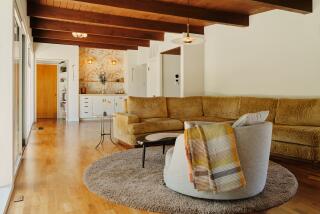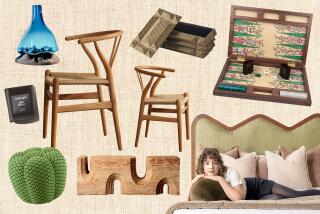Finding Comfort in British Style
Think back on the homes you’ve felt the most relaxed in. Chances are what you recall are the personal touches, those details that set rooms apart from decorated facades in a furniture store.
One way of designing to create a comfortable, personal feeling is to use aspects of the British classical style. It actually fits into Southern California homes rather easily, as long as it doesn’t get too fussy and overblown. Floral fabrics, elegant prints, Oriental rugs and china, personal collections and flowers are among the elements of the classical mode that can work even in a contemporary home.
“Accessories turn your house into a home,” says Lady Henrietta Spencer-Churchill. She is an author, fabric and wallpaper designer as well as a partner in Woodstock Designs in England, an interior design firm.
Her new book, “Classic Decorative Details” (Rizzoli, New York, $45), is full of ideas for adapting classical style into everyday homes.
As the eldest daughter of the 11th duke of Marlborough, she grew up at Blenheim Palace in Oxfordshire, England, the 18th-Century estate that was the birthplace of Winston Churchill and is now a major tourist attraction.
But you needn’t have grown up among royalty to appreciate the images in her book.
In fact, Spencer-Churchill herself lives in a farmhouse on her father’s Oxfordshire estate that she’s furnished with “good buys” and family heirlooms. She said that she doesn’t keep anything of great monetary value in her house and loves to find bargains in junk shops.
“Classic Decorative Details” gives ideas on how to save money through clever use of what you already own and through buying single pieces at flea markets and thrift shops that can be transformed into personal treasures. Those are the little finds that give rooms what Spencer-Churchill calls “instant character.”
“It’s important to buy what you like,” Spencer-Churchill said. “I’d rather see a gap on the wall than have it filled with something cheap. It’s better to have patience, save up and buy well than to buy rubbish. If you buy a good piece and then you decide you don’t like it, you can sell it or trade up. Rubbish you can’t get rid of.”
Since Britain really doesn’t follow the interior design trends that pop up in Southern California like mushrooms after a rain, rooms there often look as though generations of families have lived in them. Here that look can be created only by gradually buying and adding pieces as you find them. It is not a look that can be done correctly overnight.
“To a certain extent, we’re all forced to mix periods in room decor,” said Spencer-Churchill. “Either you can’t find what you really want or you can’t afford the original.”
Spencer-Churchill believes that a room without pictures is a room without life and without character. And the pictures don’t have to be expensive if they are interesting, framed well, hung at the correct level and lit properly. She cautions against using heavily patterned wallpaper that could clash with paintings, or wall paint that takes away their impact. Since a picture is often the focal point of a room, it should be a strong image that you particularly like and won’t get tired of looking at.
Some of the most original ideas in her book have to do with creating coffee tables.
They are often difficult to get right in a classically designed room since they didn’t exist in the past. She suggests creating coffee tables out of available materials and objects, such as an old door panel put under glass and attached to a modern base for a combined old/new look. Or using a large tray on a low base, a slab of marble on a stone pediment or even an upholstered footstool with a tray on top.
For a contemporary look, she prefers a glass top with a thin frame since the glass gives the illusion of space, and books or art objects can be placed under it for decoration.
Some of Spencer-Churchill’s advice is very practical, pointing out that taking a round piece of plywood and covering it with a cloth to create a side table can be more expensive than a modest antique. The makeshift side table is a good idea for a small bedroom or living room, though, since a television or even a small refrigerator can be hidden there when not in use.
A large part of the book deals with collections.
Spencer-Churchill says that she believes a collection of baskets can be just as decorative as a valuable set of Sevres porcelain; it’s just a different design statement.
“Historically, baskets were used in everyday life to a far greater extent than they are today,” she writes. “Farmers used them to collect their crops, fishermen used them to store their catches and vendors used them at markets to display their produce and make deliveries.”
In her book, she shows baskets stacked on top of a Pennsylvania German painted chest, jumbled together on a stairway landing, hanging on a curtain pole under a shelf in her own kitchen and suspended from rafters on old butcher’s hooks.
Among other ideas are using vases, small drawings or sculptures to break up big blocks of books on shelves; taking antique toys out of storage or the children’s rooms and putting them on hall tables, and placing candlesticks in front of mirrors to reflect light into the room.
Because Spencer-Churchill’s ideas combine the best of both British and American classical style and proportions, many of her ideas can be used here.
As she reminds us, comfort is always in, and the best homes look as if someone actually lives in them.
*
Lady Henrietta Spencer-Churchill is the honorary chairwoman of the Spring Garden Show opening party, which will be held Friday at Crystal Court, 3333 Bear St., Costa Mesa. The party benefits Designing Women, a support group of the Art Institute of Southern California in Laguna Beach. Tickets to the party are $40 each or $75 for two. She will autograph copies of her book at the event. For more information, call (714) 497-9144. The flower show is April 8 and 9 at Crystal Court.
More to Read
Sign up for The Wild
We’ll help you find the best places to hike, bike and run, as well as the perfect silent spots for meditation and yoga.
You may occasionally receive promotional content from the Los Angeles Times.






